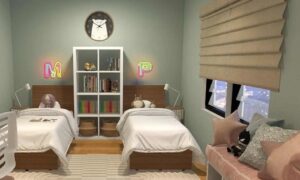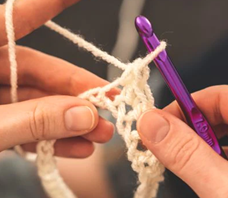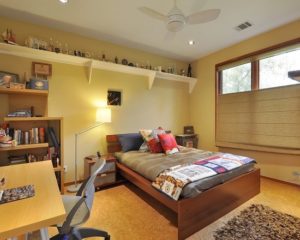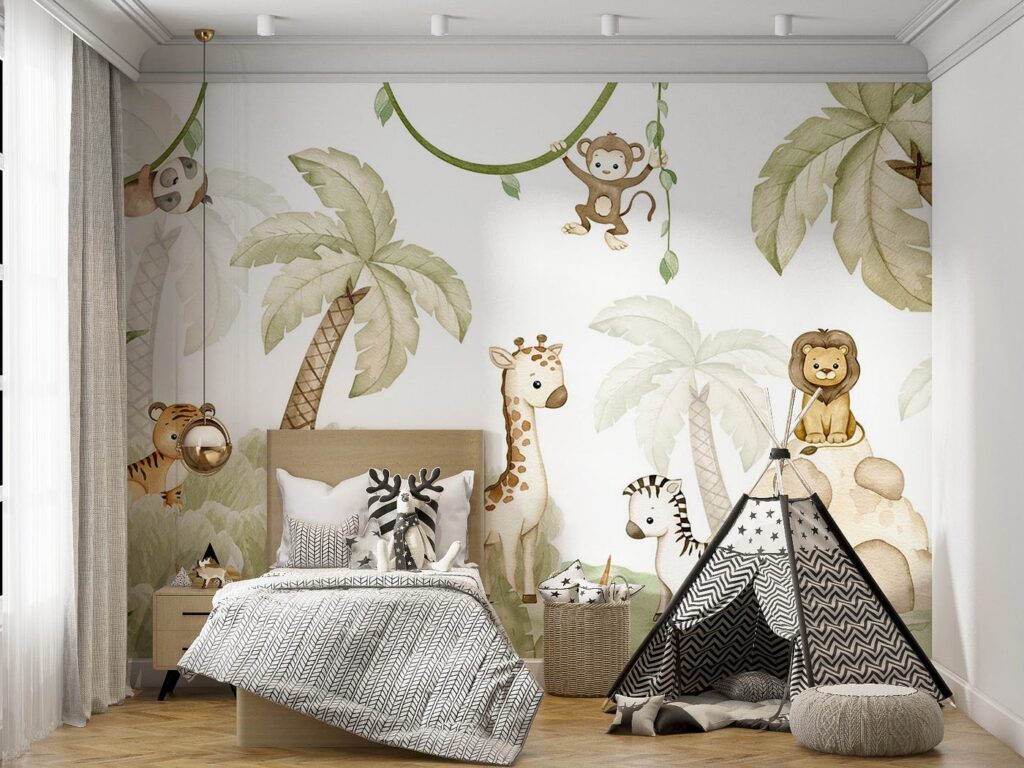
A child’s room is more than just a place to sleep. It’s a sanctuary for imagination, a launching pad for adventures, and a canvas for creativity. But with so many design considerations, it can be overwhelming to create a space that’s both functional and fosters your child’s development. Fear not, parents! This guide will equip you with ideas and inspiration to transform your child’s room into a playful paradise that sparks their wonder.
Understanding Your Child’s Needs: The Foundation for Fun
Before diving into design elements, consider your child’s age, interests, and developmental needs. Here’s a breakdown of key factors to consider:
- Age Group: Preschoolers benefit from bright colors, sensory play areas, and open space for exploration. School-aged children need dedicated areas for study, hobbies, and storage solutions for their growing belongings. Teenagers crave a space for self-expression and privacy, with areas for socializing and relaxation.
- Interests: Incorporate elements that reflect your child’s passions. For a space-obsessed child, consider a star-themed mural or glow-in-the-dark constellations on the ceiling. For a budding artist, create an art corner with a dedicated desk, chalkboard wall, or display space for their creations.
- Developmental Needs: Encourage development through design. For younger children, create a designated reading nook with comfy cushions and accessible bookshelves. As they grow, incorporate study areas with proper lighting and storage solutions for schoolwork.
Designing for Play: Zones for Exploration and Imagination
A child’s room should be an invitation to play. Here’s how to create designated zones:
- Creative Corner: This area can be a simple corner desk, a designated craft table, or a section of the wall transformed into a chalkboard or magnetic board. Stock it with age-appropriate art supplies, building blocks, or costumes to fuel their creativity.
- Reading Nook: Cultivate a love of reading with a comfy beanbag chair, a reading tent, or a dedicated reading corner with ample shelf space for their favorite books. Consider adding soft lighting for cozy reading sessions.
- Dramatic Play Area: A simple sheet draped over chairs can become a magical fort, while a play kitchen or a puppet theatre can spark imaginative play.
- Active Play Zone: If space allows, dedicate an area for indoor physical activity. This could be a simple yoga mat for movement activities or a designated space for an indoor playhouse or a climbing structure.
Beyond the Décor: Functional Considerations for a Playful Paradise
Functionality is key for a well-designed child’s room:
- Storage Solutions: Storage is crucial to avoid clutter and ensure every toy and item has its designated place. Consider colorful bins, shelves, under-bed storage solutions, and creative storage ottomans that double as seating.
- Lighting: Layered lighting is essential. Include a bright overhead light for general illumination, a dimmer switch for softer lighting during playtime, and a bedside lamp for nighttime reading.
- Safety Features: Childproof the room with outlet covers, furniture anchors, and safety gates if necessary. Ensure furniture is age-appropriate and sturdy, focusing on rounded corners to minimize bumps and bruises.
Embracing Personalization: A Room Reflecting Your Child’s Unique World
Personalization is what makes a child’s room truly special. Here’s how to make it their own:
- DIY Projects: Get crafty with your child! Paint furniture together, create a personalized wall hanging with their handprints, or design a custom growth chart.
- Display Their Artwork: Showcasing their artwork on a dedicated bulletin board, refrigerator magnets, or framed displays fosters their creativity and boosts self-esteem.
- Themed Décor: While not essential, themed décor can add to the fun. Consider themes based on their favorite book characters, movie heroes, animals, or even outer space! Remember, themes don’t have to be rigid. Let their imagination be the guide.
Safety First, Fun Always: Striking the Right Balance
While encouraging play and creativity, prioritize safety. Here are some tips:
- Age-Appropriate Toys and Furniture: Choose toys and furniture that are safe for your child’s age group. Ensure furniture is stable and avoid items with small parts that could be choking hazards.
- Supervision During Active Play: When your child engages in active play in their room, especially with younger children, provide supervision to minimize potential accidents.
- Regular Safety Checks: Routinely inspect the room for any potential hazards that may arise as your child grows and explores their space in new ways.
Beyond the Room: Extending the Playful Paradise
The playful spirit shouldn’t be confined to the walls of their room. Here’s how to extend the magic:
- Themed Playdates: Plan playdates with friends that incorporate their room’s theme. For a space-themed room, have a constellation scavenger hunt in the backyard. For an art-focused room, organize a collaborative art project.
- Incorporate Playful Elements Throughout the House: Create designated play areas in other parts of the house, like a cozy reading nook in a sunny corner of the living room or a designated craft station in the kitchen.
- Embrace Playful Activities: Schedule regular family game nights, engage in backyard adventures, or visit parks and museums to nurture a love for exploration and discovery.
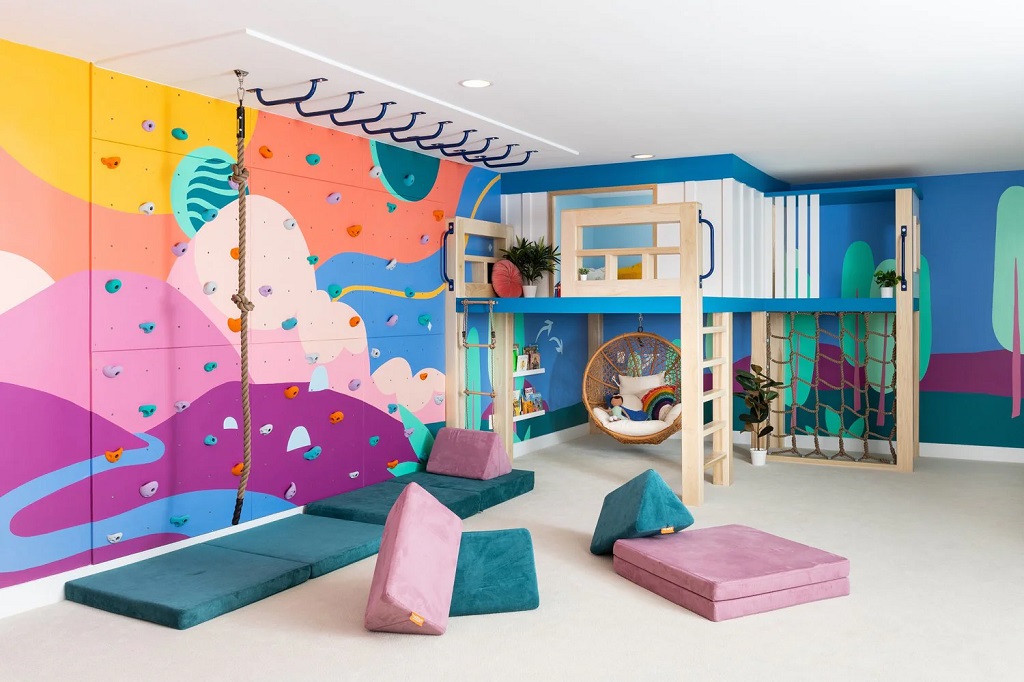
Growing with Your Child: Adapting the Playful Paradise
A child’s needs and preferences will evolve. Here’s how to adapt the space:
- Modular Furniture: Invest in modular furniture that can adapt to their changing needs. A toddler’s bed frame can convert to a twin bed, and a simple desk can transform into a workspace for a teenager.
- Removable Décor: Opt for removable wallpaper or murals that can be easily updated as their interests change. Encourage them to participate in choosing new décor elements as they grow older.
- Multi-Functional Spaces: Designate areas that can serve multiple purposes. A reading nook can double as a quiet space for homework, and a play area can be transformed into a hangout zone for teenagers.
The Takeaway: A Playful Paradise Awaits
Creating a playful paradise for your child isn’t just about aesthetics; it’s about fostering their development, sparking their imagination, and creating a space where they feel safe, loved, and encouraged to explore. Remember, the perfect playful paradise is a reflection of your child’s unique personality. With a little planning, creativity, and a focus on both functionality and fun, you can transform their room into a magical space that will spark wonder for years to come.
Related: Beyond the Picture: Using 3D Rendering to Design Your Child’s Perfect Room
Beyond the Article: Resources to Fuel Your Playful Paradise Project
Here are some resources to inspire you on your journey to create a playful paradise for your child:
- DIY and Craft Websites: Websites dedicated to DIY projects and crafts offer a wealth of ideas for creating personalized décor, storage solutions, and even themed elements for your child’s room.
- Children’s Interior Design Blogs: Gain inspiration from blogs and online publications showcasing creative and functional child’s room designs.
- Parenting Websites and Forums: Connect with other parents, share ideas, and find solutions to common challenges related to designing and organizing your child’s room.
With a little planning and creativity, you can transform your child’s room into a playful haven that fosters their development, sparks their imagination, and creates lasting memories. So, unleash your inner child, embrace the playful spirit, and get ready to watch your child’s room become a true playful paradise!





